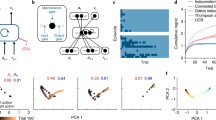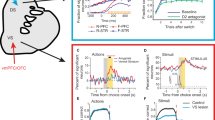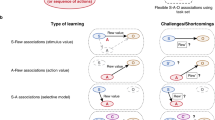Abstract
This paper presents a computational model addressing behavioral learning and planning with a fully neural approach. The prefrontal functionality that is modeled is the ability to schedule elementary action schemes to reach behavioral goals. The use of robust context detection is discussed, as well as relations to biological views of the prefrontal cortex.
Access this chapter
Tax calculation will be finalised at checkout
Purchases are for personal use only
Preview
Unable to display preview. Download preview PDF.
Similar content being viewed by others
References
Burnod, Y.: An adaptive neural network: the cerebral cortex. Masson (1989)
Dominey, P. F.: Complex sensory-motor sequence learning based on recurrent state representation and reinforcement learning. Biol Cybernetics. 73 (1995) 265–274
Frezza-Buet, H., Alexandre, F.: Modeling prefrontal functions for robot navigation. International Joint Conference on Neural Networks (1999)
Frezza-Buet, H., Rougier, N. P., Alexandre, F.: Integration of Biologically Inspired Temporal Mechanisms into a Cortical Framework for Sequence Processing. In Neural, symbolic and Reinforcement methods for sequence learning. Springer (2000)
Frezza-Buet, H., Alexandre, F.: From a biological to a computational model for the autonomous behavior of an animat. Information Sciences. In press
Fuster, J. M.: The Prefrontal Cortex: Anatomy, Physiology, and Neurophysiology of the Frontal Lobe. Lippincott Williams and Wilkins Publishers (1997)
Grafman, J., Holyoak, K. J., Boller, F., (Eds.): Structure and Functions of the Human Prefrontal Cortex. Annals of the New York Academy of Sciences. 769 (1995)
Guigon, E., Dorizzi, B., Burnod, Y., Schultz, W.: Neural correlates of learning in the prefrontal cortex of the monkey: A predictive model. the monkey. Cerebral Cortex. 5 (1995) 2:135–147
Mink, J. W.: The basal ganglia: Focused selection and inhibition of competing motor programs. Progress in Neurobiology. 50 (1996) 381–425
Schultz, W.: Dopamine neurons and their role in reward mechanisms. Current Opinion in Neurobiology. 7 (1997) 191–197
Sun, R., Alexandre, F.: Connectionist-Symbolic Integration: From Unified to Hybrid Approaches. Lawrence ErlBaum Associates (1997)
Taylor, J. G.: Learning to Generate Temporal Sequences by Models of Frontal Lobes. International Joint Conference on Neural Networks (1999)
Author information
Authors and Affiliations
Editor information
Editors and Affiliations
Rights and permissions
Copyright information
© 2002 Springer-Verlag Berlin Heidelberg
About this paper
Cite this paper
Frezza-Buet, H. (2002). Action Scheme Scheduling with a Neural Architecture: A Prefrontal Cortex Approach. In: Dorronsoro, J.R. (eds) Artificial Neural Networks — ICANN 2002. ICANN 2002. Lecture Notes in Computer Science, vol 2415. Springer, Berlin, Heidelberg. https://doi.org/10.1007/3-540-46084-5_45
Download citation
DOI: https://doi.org/10.1007/3-540-46084-5_45
Published:
Publisher Name: Springer, Berlin, Heidelberg
Print ISBN: 978-3-540-44074-1
Online ISBN: 978-3-540-46084-8
eBook Packages: Springer Book Archive




